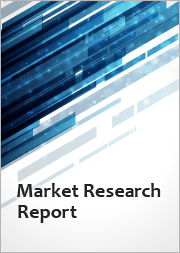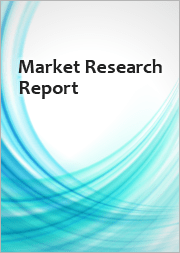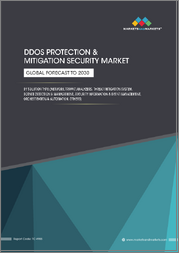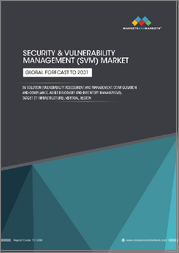
|
시장보고서
상품코드
1722999
세계의 보안 시장 규모, 점유율, 동향, 예측 : 시스템, 서비스, 최종사용자, 지역별(2025-2033년)Security Market Size, Share, Trends and Forecast by System, Service, End User, and Region, 2025-2033 |
||||||
세계 보안 시장 규모는 2024년에 1,503억 9,000만 달러에 달했습니다. 향후 IMARC Group은 2033년에는 3,110억 8,000만 달러에 달하고, 2025-2033년 8.34%의 연평균 복합 성장률(CAGR)을 보일 것으로 예측했습니다. 현재 북미가 시장의 33.8%를 차지하며 시장을 독점하고 있습니다. 사이버 공격과 지정학적 긴장 고조, 테러와 조직범죄 증가, 스마트시티의 급속한 확산, 규제 준수, 인공지능(AI) 발전 등이 보안 시장 점유율 확대를 촉진하고 있습니다.
보안 시장 분석 :
시장 성장과 규모: 세계 보안 시장은 위협에 대한 인식 증가와 기술 발전으로 인해 강력한 성장세를 보이고 있습니다.
주요 시장 성장 촉진요인 : 주요 요인: 사이버 위협 증가, 물리적 보안에 대한 우려 등
주요 시장 동향 : 인공지능(AI)과 머신러닝(ML)의 보안 시스템 통합이 두드러진 추세로, 보안 대책의 효율성과 효과를 높이고 시장 혁신을 촉진하고 있습니다.
지리적 동향 : 북미는 높은 기술 도입률과 엄격한 보안 규제로 인해 시장을 독점하고 있으며, 그 이유는 높은 기술 도입률과 엄격한 보안 규제로 인한 것입니다. 그러나 아시아태평양이 급성장하는 시장으로 부상하고 있으며, 이는 민관의 보안 강화를 위한 정부의 이니셔티브에 기인합니다.
경쟁 구도: 각 업체들은 물리적 보안과 사이버 보안을 결합한 통합 솔루션 제공에 주력하고 있으며, 엔드투엔드 커버리지를 제공하는 것을 목표로 하고 있습니다.
과제와 기회: 과제는 빠르게 진화하는 보안 위협을 포함하며, 보안 솔루션의 유효성을 보장하기 위해 지속적인 연구개발(R&D)이 필요합니다. 그러나 AI와 사물인터넷(IoT)을 통합한 보안 솔루션의 개발은 보안 시장 전망에 기회를 제공합니다.
보안 시장 동향 :
사이버 공격이 급증하면서 강력한 사이버 보안 솔루션의 필요성이 높아졌습니다.
사이버 공격의 급증은 세계 보안 시장에서 중요한 촉진제가 되고 있습니다. 사이버보안 벤처스(Cybersecurity Ventures)가 작성한 보고서에 따르면, 전 세계 사이버 범죄 비용은 2025년까지 연간 10조 5,000억 달러에 달할 것으로 예상되며, 사이버 보안 대책의 개선이 시급한 것으로 나타났습니다. 000억 달러 이상에 달할 것으로 추정되며, 사이버 보안 대책의 개선이 시급하다는 점을 강조하고 있습니다. 또한, IBM에 따르면 2023년 데이터 침해의 세계 평균 비용은 445만 달러로 3년간 15% 증가했으며, 미국이 509만 달러를 넘어 가장 높은 비용을 부담하고 있다고 합니다. 이와는 별도로 Statista가 수집한 데이터에 따르면 2023년 전 세계 조직의 72.7% 이상이 랜섬웨어 공격의 희생양이 되었으며, 2022년 2월 IBM Corp.은 사이버 보안 리소스를 확대하기 위해 수백만 달러를 투자할 것이라고 발표했습니다. APAC 지역 전체에서 증가하는 사이버 공격 위협에 대비하고 관리하는 비즈니스를 더욱 지원할 것입니다.
지정학적 긴장과 국방기술에 대한 수요
지정학적 긴장과 지역 분쟁은 세계 보안 시장에 큰 영향을 미치고 있습니다. 각국이 국가 안보를 최우선 과제로 삼으면서 혁신적인 국방 솔루션 연구개발(R&D)에 대한 투자가 증가하고 있습니다. 예를 들어, 미국 국방부는 새로운 인수 및 예산 편성 권한을 통해 상용 기술에 대한 접근성을 확보하고 국방 혁신 부서의 존재감을 높이기 위해 노력했습니다. 그 결과, 2023년 자율적인 공중, 지상, 지상, 지하 및/또는 우주 시스템의 신속한 실전 투입을 위한 '리플리컨트(Replicant)' 이니셔티브를 설립했습니다. 마찬가지로 2024년 3월 NATO의 북대서양 방위 혁신 가속기(DIANA)는 대서양 횡단 가속기 사이트 및 테스트 센터 네트워크의 확장을 발표하여 방위 분야 혁신가를 지원하는 DIANA의 역량을 강화했으며, 2023년 9월 영국의 보안 및 인공지능(AI) 기업 인 헬싱(Helsing)은 국방 분야에 특화된 서비스를 제공하기 위해 스웨덴의 항공우주 및 방위 기업 Saab AB와 전략적 협력 계약을 체결했습니다. Saab AB는 Helsing GmbH의 주식 5%를 현금으로 7,500만 유로를 투자했습니다. 이번 파트너십의 목적은 헬싱의 첨단 AI 역량과 Saab의 하드웨어 기반 센서 및 자기 방어 시스템을 결합하여 고객과 조직의 진화하는 요구에 부응하기 위해 Saab의 포트폴리오를 더욱 개선하는 것입니다.
테러 증가와 고도화된 위협 감지
테러리즘과 조직범죄 증가는 첨단 위협 감지 및 예방 메커니즘에 대한 중요한 요구를 뒷받침하고 있습니다. 위협의 성격이 진화함에 따라 최첨단 보안 기술의 지속적인 개발 및 배포는 사회를 보호하고 공공 안전을 유지하는 데 매우 중요합니다. 예를 들어, 2022년 12월 LogRhythm Inc.는 통합 엔터프라이즈 솔루션을 제공하기 위해 자율형 사이버 보안 플랫폼 기업인 SentinelOne과 파트너십을 체결했다고 발표했습니다. 이번 통합은 중앙 집중식 데이터 수집을 통한 가시성 확대, 자동화 시작, 복잡성 감소를 통해 보안 운영을 더욱 간소화하고 대응 워크플로우를 개선하는 것을 목표로 하고 있습니다. 양사는 향후 분석 기능을 강화한 고급 위협 인텔리전스 기능을 제공하여 전 세계 사이버 보안 위험 감소를 목표로 하고 있습니다.
목차
제1장 서문
제2장 조사 범위와 조사 방법
- 조사 목적
- 이해관계자
- 데이터 소스
- 1차 정보
- 2차 정보
- 시장 추정
- 보텀업 접근
- 톱다운 접근
- 조사 방법
제3장 주요 요약
제4장 서론
- 개요
- 주요 업계 동향
제5장 세계의 보안 시장
- 시장 개요
- 시장 실적
- COVID-19의 영향
- 시장 예측
제6장 시장 분석 : 시스템별
- 액세스 제어
- 경보 및 통지
- 침입 감지
- 비디오 감시
- 배리어
- 기타
제7장 시장 분석 : 서비스별
- 시스템 통합 및 컨설팅
- 리스크 평가 및 분석
- 매니지드 서비스
- 유지관리 및 지원
제8장 시장 분석 : 최종사용자별
- 정부
- 군 및 방위
- 운송
- 상업
- 산업
- 기타
제9장 시장 분석 : 지역별
- 북미
- 미국
- 캐나다
- 아시아태평양
- 중국
- 일본
- 인도
- 한국
- 호주
- 인도네시아
- 기타
- 유럽
- 독일
- 프랑스
- 영국
- 이탈리아
- 스페인
- 러시아
- 기타
- 라틴아메리카
- 브라질
- 멕시코
- 기타
- 중동 및 아프리카
- 시장 내역 : 국가별
제10장 SWOT 분석
- 개요
- 강점
- 약점
- 기회
- 위협
제11장 밸류체인 분석
제12장 Porter의 Five Forces 분석
- 개요
- 바이어의 교섭력
- 공급 기업의 교섭력
- 경쟁 정도
- 신규 진출업체의 위협
- 대체품의 위협
제13장 가격 분석
제14장 경쟁 구도
- 시장 구조
- 주요 기업
- 주요 기업 개요
- Ameristar Perimeter Security(Assa Abloy AB)
- ATG Access Ltd.
- Avon Barrier Corporation Ltd.(Perimeter Protection Group)
- Barrier1 Systems LLC
- CIAS Elettronica Srl
- Delta Scientific Corporation
- EL-Go Team
- Frontier Pitts Ltd.
- Honeywell International Inc.
- Johnson Controls International PLC
- Senstar Corporation(Senstar Technologies Ltd.)
- Teledyne FLIR LLC(Teledyne Technologies Incorporated)
The global security market size was valued at USD 150.39 Billion in 2024. Looking forward, IMARC Group estimates the market to reach USD 311.08 Billion by 2033, exhibiting a CAGR of 8.34% from 2025-2033. North America currently dominates the market, with 33.8% of the market share. The escalating cyberattacks and geopolitical tensions, rising terrorism and organized crime, rapid expansion of smart cities, regulatory compliance, and advancements in artificial intelligence (AI) are facilitating the expansion of the security market share.
Security Market Analysis:
Market Growth and Size: The global security market is experiencing strong growth, driven by the increasing awareness about threats and advancements in technology.
Major Market Drivers: Key factors include the rising cyber security threats and physical security concerns.
Key Market Trends: The integration of artificial intelligence (AI) and machine learning (ML) in security systems is a prominent trend, enhancing the efficiency and effectiveness of security measures and fostering market innovation.
Geographical Trends: North America dominates the market, attributed to high technology adoption rates and stringent security regulations. However, Asia-Pacific is emerging as a fast-growing market, which can be attributed to the government's initiatives towards enhancing public and private sector security.
Competitive Landscape: Companies are focusing on offering integrated solutions that combine physical and cybersecurity, aiming to provide end-to-end coverage, which is a critical factor in gaining a competitive edge in the market.
Challenges and Opportunities: Challenges include the rapidly evolving security threats, which require continuous research and development (R&D) to ensure the effectiveness of security solutions. Nonetheless, the development of AI and internet of things (IoT)-integrated security solutions are offering a favorable opportunities to the security market outlook.
Security Market Trends:
Escalating cyberattacks emphasizing the need for robust cybersecurity solutions
The upsurge in cyberattacks has emerged as a prominent driver within the global security market. As businesses become more interconnected and reliant on digital operations, the demand for comprehensive cybersecurity strategies continues to soar. According to the report formulated by Cybersecurity Ventures, worldwide cybercrime costs are estimated to cross US$ 10.5 trillion annually by 2025, emphasizing the urgent need for improved cybersecurity measures. Additionally, as per IBM, in 2023, the global average cost of a data breach was US$ 4.45 million, a 15% increase over three years, with the United States bearing the highest cost of a data breach, exceeding US$ 5.09 million. Apart from this, the data gathered from Statista suggested that in 2023, over 72.7% of all organizations globally fell prey to a ransomware attack. In February 2022, IBM Corp. announced a multi-million dollar investment to expand its resources in cyber security, further helping businesses prepare for and manage the growing threat of cyberattack across APAC region.
Geopolitical tensions and demand for defense technologies
Geopolitical tensions and regional conflicts exert a significant influence on the global security market. As nations prioritize national security, investments in research and development (R&D) of innovative defense solutions rise. For instance, the US Department of Defense, through new acquisitions and budgeting authorities, aimed to gain access to commercial technology to increase the prominence of the Defense Innovation Unit. As a result, they established the Replicator initiative in 2023 to rapidly field autonomous aerial, ground, surface, sub-surface, and/or space systems. Similarly, in March 2024, NATO's DIANA (Defense Innovation Accelerator for the North Atlantic) announced the expansion of its transatlantic network of accelerator sites and test centre, augmenting DIANA's capacity to support innovators in the defense sector. In September 2023, Helsing, a UK-based security and artificial intelligence (AI) company that is focused on serving the defense sector, signed a strategic cooperation agreement with Saab AB, which is a Swedish aerospace and defense company. Saab AB made an investment of EUR 75 million in cash for a 5% stake in Helsing GmBH. The aim of the partnership was to combine Helsing's highly advanced AI capabilities with Saab's hardware-based sensors and self-protection systems, further improving Saab's portfolio to meet the evolving needs of customers and organziations.
Rising instances of terrorism and advanced threat detection
The escalating instances of terrorism and organized crime underpin the critical need for advanced threat detection and prevention mechanisms. As the nature of threats evolves, the continuous development and deployment of state-of-the-art security technologies remain pivotal in safeguarding societies and maintaining public safety. For example, in December 2022, LogRhythm Inc. announced its partnership with SentinelOne, an autonomous cybersecurity platform company, to provide an integrated enterprise solution. This integration aims to expand visibility through centralized data collection, initiate automation, and reduce complexity, further streamlining security operations and improving response workflow. Together, the companies will offer advanced threat intelligence capabilities with enhanced analytics to reduce the number of cybersecurity risks globally.
Security Industry Segmentation:
Breakup by System:
- Access Control Systems
- Alarms and Notification Systems
- Intrusion Detection Systems
- Video Surveillance Systems
- Barrier Systems
- Others
Video surveillance systems dominate the market
The video surveillance systems segment is dominating the security market due to the increasing need for crime prevention and public safety. In line with this, rapid urbanization has considerably surged the requirement for monitoring public spaces, transportation hubs, and critical infrastructure intensifies, which is supporting the security market growth. Moreover, technological advancements such as high-definition cameras, video analytics, and real-time monitoring capabilities enhance the effectiveness of surveillance systems, making them indispensable tools for law enforcement and security personnel. Additionally, the integration of video surveillance with other security technologies like access control and intrusion detection creates comprehensive security ecosystems that offer seamless threat detection and response. Furthermore, regulatory mandates and compliance requirements in sectors such as retail, finance, and healthcare propel the adoption of video surveillance systems to ensure compliance and deter unauthorized activities.
Breakup by Service:
- System Integration and Consulting
- Risk Assessment and Analysis
- Managed Services
- Maintenance and Support
System integration and consulting dominates the market
The system integration and consulting segment is driven by several key factors, including the increasing complexity of modern business processes and technologies, which has necessitated expert guidance to seamlessly integrate diverse systems and applications. This complexity arises from the need to optimize operations, enhance efficiency, and ensure data consistency across an organization's IT ecosystem. Moreover, the rapid pace of technological innovation compels businesses to continually adopt and adapt new tools and platforms. System integration and consulting provide the expertise needed to select, customize, and integrate these technologies effectively, enabling companies to remain competitive in dynamic markets. Additionally, the demand for streamlined workflows and enhanced user experiences drives organizations to seek holistic solutions that bridge gaps between various systems. System integration and consulting services play a pivotal role in crafting solutions that align with specific business goals, facilitating smoother operations and improved user interactions. The market underscores the importance of system integration and consulting services in addressing the increasingly complex cybersecurity landscape.
Breakup by End User:
- Government
- Military and Defense
- Transportation
- Commercial
- Industrial
- Others
Military and defense dominates the market
The military and defense segment is influenced by geopolitical tensions and regional conflicts, which has driven nations to prioritize their defense capabilities, leading to increased investments in military modernization and technological advancements. Moreover, the need to counter evolving security threats, such as cyberattacks and asymmetric warfare, fuels demand for cutting-edge defense technologies and strategies. Additionally, the pursuit of national security and sovereignty prompts governments to enhance their defense preparedness, leading to investments in areas like intelligence, surveillance, and reconnaissance systems. Furthermore, the emergence of non-traditional threats like pandemics and environmental crises highlights the importance of versatile defense capabilities that can address a range of challenges. The collaborations between nations in joint defense projects also contribute to the growth of the military and defense segment.
Breakup by Region:
- North America
- United States
- Canada
- Asia Pacific
- China
- Japan
- India
- South Korea
- Australia
- Indonesia
- Others
- Europe
- Germany
- France
- United Kingdom
- Italy
- Spain
- Russia
- Others
- Latin America
- Brazil
- Mexico
- Others
- Middle East and Africa
North America exhibits a clear dominance, accounting for the largest security market share
The market research report has also provided a comprehensive analysis of all the major regional markets, which include North America (the United States and Canada); Europe (Germany, France, the United Kingdom, Italy, Spain, Russia, and others); Asia Pacific (China, Japan, India, South Korea, Australia, Indonesia, and others); Latin America (Brazil, Mexico, and others); and the Middle East and Africa. According to the report, North America accounted for the largest market share.
In North America, several key factors drive the dynamics of the security market, including the region's technological advancement and widespread digitalization create a pressing need for robust cybersecurity measures. With a significant reliance on digital platforms for commerce, communication, and critical infrastructure, the demand for advanced threat detection, encryption, and data protection solutions remains high. Furthermore, the region's geopolitical landscape, marked by international trade dynamics and diplomatic relations, underscores the importance of defense technologies. The need to ensure national security, counter potential threats, and support allied nations drives investments in defense systems, surveillance technologies, and military communication networks. Apart from this, the region's proactive approach towards addressing evolving threats, such as terrorism and cyberattacks, fosters a climate of innovation. This encourages the development and implementation of cutting-edge security solutions, leveraging technologies like artificial intelligence (AI), biometrics, and internet of things (IoT) integration to provide comprehensive protection across physical and digital domains.
Competitive Landscape:
The competitive landscape of the global security market is characterized by a dynamic interplay of factors that shape the industry's trajectory. Intense market competition, driven by the increasing demand for security solutions, prompts companies to innovate and differentiate their offerings. This landscape is further influenced by the rapid evolution of technology, where advancements in cybersecurity, surveillance, and threat detection continually redefine industry standards.
The expansion of smart cities, the proliferation of IoT devices, and the integration of AI-driven analytics contribute to the complexity of the market. Additionally, regulatory requirements and compliance standards play a crucial role in shaping the competitive dynamics, as companies must adhere to stringent data protection and privacy mandates. Market players must adeptly balance innovation, quality, and affordability to meet the diverse needs of clientele ranging from governments and enterprises to individuals. Amidst these challenges, the competitive landscape continues to evolve, presenting opportunities for those who can effectively navigate the intricate intersections of technology, regulation, and customer expectations.
The report has provided a comprehensive analysis of the competitive landscape in the market. Detailed profiles of all major companies have also been provided. Some of the key players in the market include:
- Ameristar Perimeter Security (Assa Abloy AB)
- ATG Access Ltd.
- Avon Barrier Corporation Ltd. (Perimeter Protection Group)
- Barrier1 Systems LLC
- CIAS Elettronica Srl
- Delta Scientific Corporation
- EL-Go Team
- Frontier Pitts Ltd.
- Honeywell International Inc.
- Johnson Controls International PLC
- Senstar Corporation (Senstar Technologies Ltd.)
- Teledyne FLIR LLC (Teledyne Technologies Incorporated)
Key Questions Answered in This Report
- 1.How big is the security market?
- 2.What is the future outlook of security market?
- 3.What are the key factors driving the security market?
- 4.Which region accounts for the largest security market share?
- 5.Which are the leading companies in the global security market?
Table of Contents
1 Preface
2 Scope and Methodology
- 2.1 Objectives of the Study
- 2.2 Stakeholders
- 2.3 Data Sources
- 2.3.1 Primary Sources
- 2.3.2 Secondary Sources
- 2.4 Market Estimation
- 2.4.1 Bottom-Up Approach
- 2.4.2 Top-Down Approach
- 2.5 Forecasting Methodology
3 Executive Summary
4 Introduction
- 4.1 Overview
- 4.2 Key Industry Trends
5 Global Security Market
- 5.1 Market Overview
- 5.2 Market Performance
- 5.3 Impact of COVID-19
- 5.4 Market Forecast
6 Market Breakup by System
- 6.1 Access Control Systems
- 6.1.1 Market Trends
- 6.1.2 Market Forecast
- 6.2 Alarms and Notification Systems
- 6.2.1 Market Trends
- 6.2.2 Market Forecast
- 6.3 Intrusion Detection Systems
- 6.3.1 Market Trends
- 6.3.2 Market Forecast
- 6.4 Video Surveillance Systems
- 6.4.1 Market Trends
- 6.4.2 Market Forecast
- 6.5 Barrier Systems
- 6.5.1 Market Trends
- 6.5.2 Market Forecast
- 6.6 Others
- 6.6.1 Market Trends
- 6.6.2 Market Forecast
7 Market Breakup by Service
- 7.1 System Integration and Consulting
- 7.1.1 Market Trends
- 7.1.2 Market Forecast
- 7.2 Risk Assessment and Analysis
- 7.2.1 Market Trends
- 7.2.2 Market Forecast
- 7.3 Managed Services
- 7.3.1 Market Trends
- 7.3.2 Market Forecast
- 7.4 Maintenance and Support
- 7.4.1 Market Trends
- 7.4.2 Market Forecast
8 Market Breakup by End User
- 8.1 Government
- 8.1.1 Market Trends
- 8.1.2 Market Forecast
- 8.2 Military and Defense
- 8.2.1 Market Trends
- 8.2.2 Market Forecast
- 8.3 Transportation
- 8.3.1 Market Trends
- 8.3.2 Market Forecast
- 8.4 Commercial
- 8.4.1 Market Trends
- 8.4.2 Market Forecast
- 8.5 Industrial
- 8.5.1 Market Trends
- 8.5.2 Market Forecast
- 8.6 Others
- 8.6.1 Market Trends
- 8.6.2 Market Forecast
9 Market Breakup by Region
- 9.1 North America
- 9.1.1 United States
- 9.1.1.1 Market Trends
- 9.1.1.2 Market Forecast
- 9.1.2 Canada
- 9.1.2.1 Market Trends
- 9.1.2.2 Market Forecast
- 9.1.1 United States
- 9.2 Asia-Pacific
- 9.2.1 China
- 9.2.1.1 Market Trends
- 9.2.1.2 Market Forecast
- 9.2.2 Japan
- 9.2.2.1 Market Trends
- 9.2.2.2 Market Forecast
- 9.2.3 India
- 9.2.3.1 Market Trends
- 9.2.3.2 Market Forecast
- 9.2.4 South Korea
- 9.2.4.1 Market Trends
- 9.2.4.2 Market Forecast
- 9.2.5 Australia
- 9.2.5.1 Market Trends
- 9.2.5.2 Market Forecast
- 9.2.6 Indonesia
- 9.2.6.1 Market Trends
- 9.2.6.2 Market Forecast
- 9.2.7 Others
- 9.2.7.1 Market Trends
- 9.2.7.2 Market Forecast
- 9.2.1 China
- 9.3 Europe
- 9.3.1 Germany
- 9.3.1.1 Market Trends
- 9.3.1.2 Market Forecast
- 9.3.2 France
- 9.3.2.1 Market Trends
- 9.3.2.2 Market Forecast
- 9.3.3 United Kingdom
- 9.3.3.1 Market Trends
- 9.3.3.2 Market Forecast
- 9.3.4 Italy
- 9.3.4.1 Market Trends
- 9.3.4.2 Market Forecast
- 9.3.5 Spain
- 9.3.5.1 Market Trends
- 9.3.5.2 Market Forecast
- 9.3.6 Russia
- 9.3.6.1 Market Trends
- 9.3.6.2 Market Forecast
- 9.3.7 Others
- 9.3.7.1 Market Trends
- 9.3.7.2 Market Forecast
- 9.3.1 Germany
- 9.4 Latin America
- 9.4.1 Brazil
- 9.4.1.1 Market Trends
- 9.4.1.2 Market Forecast
- 9.4.2 Mexico
- 9.4.2.1 Market Trends
- 9.4.2.2 Market Forecast
- 9.4.3 Others
- 9.4.3.1 Market Trends
- 9.4.3.2 Market Forecast
- 9.4.1 Brazil
- 9.5 Middle East and Africa
- 9.5.1 Market Trends
- 9.5.2 Market Breakup by Country
- 9.5.3 Market Forecast
10 SWOT Analysis
- 10.1 Overview
- 10.2 Strengths
- 10.3 Weaknesses
- 10.4 Opportunities
- 10.5 Threats
11 Value Chain Analysis
12 Porters Five Forces Analysis
- 12.1 Overview
- 12.2 Bargaining Power of Buyers
- 12.3 Bargaining Power of Suppliers
- 12.4 Degree of Competition
- 12.5 Threat of New Entrants
- 12.6 Threat of Substitutes
13 Price Analysis
14 Competitive Landscape
- 14.1 Market Structure
- 14.2 Key Players
- 14.3 Profiles of Key Players
- 14.3.1 Ameristar Perimeter Security (Assa Abloy AB)
- 14.3.1.1 Company Overview
- 14.3.1.2 Product Portfolio
- 14.3.2 ATG Access Ltd.
- 14.3.2.1 Company Overview
- 14.3.2.2 Product Portfolio
- 14.3.3 Avon Barrier Corporation Ltd. (Perimeter Protection Group)
- 14.3.3.1 Company Overview
- 14.3.3.2 Product Portfolio
- 14.3.4 Barrier1 Systems LLC
- 14.3.4.1 Company Overview
- 14.3.4.2 Product Portfolio
- 14.3.5 CIAS Elettronica Srl
- 14.3.5.1 Company Overview
- 14.3.5.2 Product Portfolio
- 14.3.6 Delta Scientific Corporation
- 14.3.6.1 Company Overview
- 14.3.6.2 Product Portfolio
- 14.3.7 EL-Go Team
- 14.3.7.1 Company Overview
- 14.3.7.2 Product Portfolio
- 14.3.8 Frontier Pitts Ltd.
- 14.3.8.1 Company Overview
- 14.3.8.2 Product Portfolio
- 14.3.9 Honeywell International Inc.
- 14.3.9.1 Company Overview
- 14.3.9.2 Product Portfolio
- 14.3.9.3 Financials
- 14.3.9.4 SWOT Analysis
- 14.3.10 Johnson Controls International PLC
- 14.3.10.1 Company Overview
- 14.3.10.2 Product Portfolio
- 14.3.10.3 Financials
- 14.3.10.4 SWOT Analysis
- 14.3.11 Senstar Corporation (Senstar Technologies Ltd.)
- 14.3.11.1 Company Overview
- 14.3.11.2 Product Portfolio
- 14.3.12 Teledyne FLIR LLC (Teledyne Technologies Incorporated)
- 14.3.12.1 Company Overview
- 14.3.12.2 Product Portfolio
- 14.3.12.3 Financials
- 14.3.12.4 SWOT Analysis
- 14.3.1 Ameristar Perimeter Security (Assa Abloy AB)



















